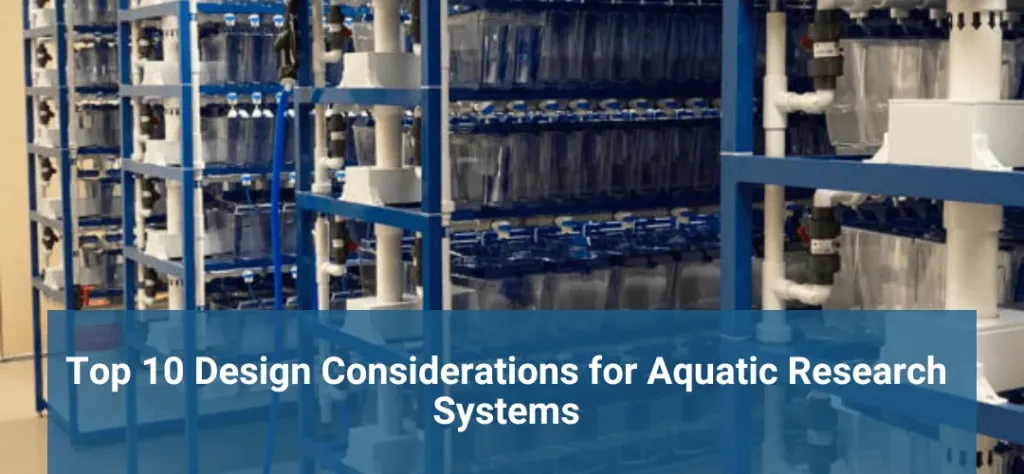Top 10 Design Considerations for Aquatic Research Systems

Aquatic research systems are an essential tool to research different aquatic species such as Zebrafish, Xenopus, Cephalopods, Cuttlefish and much more. To maximize the effectiveness of these tools it’s crucial to understand the design elements that can improve your research results and ensure precision. It’s not about choosing equipment; it involves understanding how different design components interact to create a dependable and effective research setting.
When working with marine species, the design of your research system plays a crucial role in improving the accuracy of your findings and simplifying the management of your research setup. By focusing on these design factors you can boost your research capacity, safeguard the welfare of your subjects and attain results that are both dependable and significant. Let’s explore of the 10 design aspects to consider when selecting an ideal aquatic research system.
1. Water Quality Management
Importance: The quality of water plays a role in any research system. Aquatic species are extremely sensitive in their surroundings underscoring the importance of water quality for research results. It is vital to keep an eye on and regulate factors such as temperature, pH, and conductivity, within defined thresholds.
Tools and Technologies: Investing in advanced water quality monitoring tools can greatly benefit your research. Automated sensors and data loggers can continuously track water conditions and provide real-time feedback. Additionally, using high-quality water treatment systems, such as UV sterilizers and activated carbon filters, can help maintain optimal water quality.
Regular Monitoring and Calibration: Consistent monitoring and calibration of your water quality instruments are crucial. Regular testing for contaminants and adjustments to water treatment processes ensure that the system remains stable and reliable. Establish a routine schedule for these tasks to prevent any unexpected fluctuations in water quality.
2. Temperature Control
The Role of Temperature in Aquatic Systems: Temperature control is vital for maintaining the health of aquatic organisms and the accuracy of your research. Different species have specific temperature requirements, and deviations can affect their behavior, growth, and overall well-being.
Temperature Control Systems: To manage temperature effectively, equip your system with high-quality heating and cooling units. Programmable thermostats and temperature controllers can help maintain precise conditions. Additionally, consider using backup heating and cooling systems to ensure continuous temperature regulation, even in case of equipment failure.
Monitoring and Alarming: Implement temperature monitoring systems with alarm features that notify you of any significant deviations from the set parameters. This proactive approach allows you to address potential issues before they impact your research.
3. Water Circulation and Filtration
Importance of Effective Circulation: Proper water circulation is essential for preventing dead zones and ensuring uniform distribution of nutrients and oxygen. Good circulation promotes a healthy environment for aquatic organisms and improves the efficiency of filtration systems.
Choosing Circulation Pumps: Select high-quality circulation pumps that are appropriate for the size and type of your system. Adjustable flow rates and energy-efficient models can enhance system performance while reducing operational costs.
Filtration Options: The choice of filtration technology can impact water clarity and quality. Consider using a combination of mechanical, biological, and chemical filtration methods to address various types of contaminants. Regular maintenance and replacement of filter media are also important for optimal filtration.
4. System Scalability
The Need for Scalability: Scalability is a crucial consideration if your research needs are expected to evolve. A system that can be easily expanded or modified allows you to accommodate additional species, increase water volume, or integrate new technologies without significant disruptions.
Modular Design Features: Opt for modular components that can be added or upgraded as needed. Modular tanks, expandable filtration systems, and adjustable circulation units offer flexibility and ease of adaptation to changing research requirements.
Future-Proofing Your System: When planning for scalability, consider future technological advancements and research trends. Choose systems and components that can be upgraded or replaced with minimal effort to keep pace with evolving scientific needs.
5. Ease of Maintenance
Importance of Routine Maintenance: Regular maintenance is key to ensuring the longevity and efficiency of your aquatic research system. Easy access to components that require frequent servicing can save time and reduce the risk of system downtime.
Design for Accessibility: Design features such as removable panels, accessible filter compartments, and clear documentation can facilitate routine maintenance tasks. User-friendly interfaces and instructional guides also contribute to efficient system upkeep.
Preventative Maintenance: Implement a preventative maintenance schedule to address potential issues before they become major problems. This includes regular inspections, cleaning, and part replacements according to manufacturer recommendations.
6. Emergency Backup Systems
The Need for Backup Systems: Emergency backup systems are essential for protecting your research in case of power outages, equipment failures, or other unexpected events. These systems help prevent disruptions and safeguard your research investments.
Types of Backup Systems: Consider incorporating backup power supplies, such as uninterruptible power supplies (UPS) or generators, to maintain system operations during power outages. Redundant filtration and circulation systems can provide additional security in case of primary system failures.
Developing Emergency Protocols: Establish clear emergency protocols and response plans to address potential issues quickly. Training staff on these procedures and conducting regular drills can ensure that you are prepared to handle emergencies effectively.
7. Compatibility with Research Objectives
Aligning System Design with Research Goals: The design of your aquatic research system should align with the specific objectives of your research. This includes meeting the environmental needs of your research organisms and accommodating any special experimental setups.
Customization Options: Look for systems that offer customization options, such as adjustable water chemistry controls, specialized habitat structures, or adaptable tank configurations. Customizable features allow you to tailor the system to the unique requirements of your research projects.
Integration with Research Equipment: Ensure that the aquatic research system can integrate with other research equipment, such as microscopes, imaging systems, or data analysis tools. Seamless integration enhances the efficiency and effectiveness of your research processes.
8. User-Friendly Interface
Importance of an Intuitive Interface: A user-friendly interface is essential for managing and operating your aquatic research system efficiently. An intuitive interface allows you to easily monitor and adjust system settings, reducing the likelihood of errors and improving overall productivity.
Features of a Good Interface: Look for systems with clear, easy-to-navigate displays, touchscreen controls, and real-time data monitoring. Software that provides data logging, trend analysis, and customizable alerts can enhance your ability to track and manage research variables.
Training and Support: Ensure that adequate training and support are available for using the system’s interface. Comprehensive user manuals, online resources, and customer support services can help you maximize the system’s capabilities and troubleshoot any issues.
9. Safety Considerations
Prioritizing Safety: Safety is a top priority when working with aquatic research systems. Proper design and safety features help protect both researchers and the aquatic organisms in your care.
Safety Features and Protocols: Incorporate safety features such as secure tank enclosures, spill containment systems, and proper ventilation. Ensure that electrical components are installed following safety standards and that emergency shutoff mechanisms are in place.
Training and Compliance: Provide training on safety protocols and best practices for operating the system. Adhere to industry regulations and standards to ensure compliance and maintain a safe working environment.
10. Cost and Budget
Balancing Cost and Quality: When selecting an aquatic research system, balancing cost and quality is crucial. While it’s important to invest in high-quality equipment, it’s also essential to stay within your budget.
Evaluating Long-Term Costs: Consider not only the initial purchase cost but also the long-term operational expenses, including maintenance, energy consumption, and replacement parts. Analyzing these costs can help you make an informed decision that aligns with your budget.
Exploring Funding Options: Explore funding opportunities or grants that may be available to support the acquisition and maintenance of aquatic research systems. Financial assistance can help offset costs and enable you to invest in high-quality equipment. Engaging in the development and utilization of a research system requires evaluation of multiple aspects to guarantee efficient functionality and dependability. Prioritizing tasks such, as managing water quality, regulating temperature, ensuring water flow, scalability, ease of maintenance, emergency readiness, alignment with research goals, user friendly interface design, safety measures and cost management can elevate the effectiveness of your research efforts. Devoting time to comprehend and tackle these factors will ultimately bolster the success and productivity of your research pursuits.



